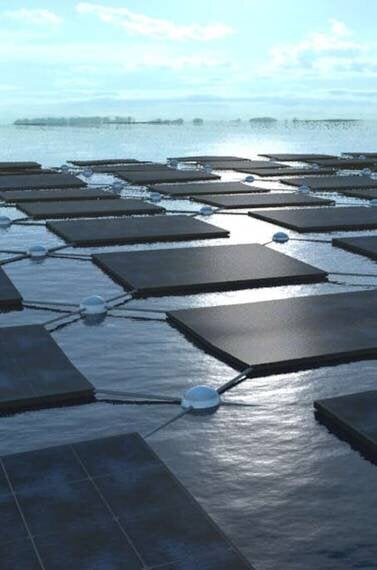
Back in 1931, Thomas Edison announced, "I'd put my money on the sun and solar energy. What a source of power! I hope we don't have to wait until oil and gas run out before we tackle that."
He was right: every 40 minutes, enough sunlight falls on the earth's landmass to power the planet for a year. Inspired by the incredible possibilities, I developed the concept of Marine Solar Cells - floating "solar farms" which gather energy from the sun to generate clean, renewable power.
My idea, dating from 2010, is now popping up in real world applications and water-based solar developments all over the globe.
Sowing the seeds
I created the Marine Solar Cell concept to capitalise on the plummeting cost of solar energy and the increasing demand on real estate, sparked by the global shift towards green energy production techniques.
The benefits of floating solar farms were obvious to me. Land-based solar panels continue to be hampered by high land costs and competition for space, as well being subject to aesthetic and environmental restrictions. My vision was that these energy-generating arrays would also provide additional benefits, offering protection against coastal erosion and protecting marine habitats.
Utilising unique amorphous silicon applications and manufacturing processes, Marine Solar Cells offered a sustainable way to meet the energy challenges facing the offshore industries.
I presented the original concept at the World Future Energy Summit in Abu Dhabi in 2011, and then at the European Space Solutions event in 2012, to a fantastic reception. The technology was featured extensively online and received global media coverage in the same year.

What's the latest?
Since then, costs have fallen still further, efficiency has improved, and the popularity of photovoltaic technology has rocketed as a consequence.
September 2014 saw the UK's first floating solar panels installed on the reservoir of a fruit farm in Berkshire. Developed by French company Ciel et Terre, it's expected that the 800 panels will pay for themselves within six years, delivering a minimum profit of £620,000 over two decades. Owner Mark Bennett is set to gather over £20,000 a year in consumer-funded subsidies and save around £24,000 a year by not having to buy in power from the National Grid.
Small states and island counties with little spare land were some of those I imagined really benefitting from the technology. Initially, I was approached by India, Japan and Singapore.
The Public Utilities Board of densely populated Singapore is now planning to build a pilot solar farm on the Tengeh Reservoir to power 1,000 local homes. In parallel, 2015 will see testing begin on a floating solar panel array off the coast of Malta - a country that's currently struggling to meet strict EU standards on green energy production.
But it seems as though Japan is becoming the big player, as it urgently seeks to ease its reliance on nuclear power. The Kagoshima solar power plant was launched into the sea in late 2013, and now the country is building two huge solar panel 'islands' on reservoirs. The annual production is likely to be 70 MWh, making it the world's largest floating solar power plant. The cooling effect of the water is set to increase energy output from the floating panels, compared to ground-mounted or rooftop panels.
Other floating solar farms are currently installed and in the process of being commissioned in other places around the world, such as India and the USA.

Moving to a hybrid system
I later developed my initial idea for floating solar panels into a hybrid system in which the technology could also capture wave energy through natural buoyancy displacement. The next stage for current ocean-based solar farm projects would be to incorporate this dual aspect of energy generation.
Approximately two percent of the world's coastal waters have wave power densities sufficient for generating useable energy. This equates to 480GW of power output or 4,200 TWh/year.
There is now great scope to pioneer an International Ocean Energy System. There are huge global implications for these emerging developments, and I still firmly believe that the idea can - and will - change the face of renewable energy.
Find out more about PAULEY's Marine Solar Cells concept here.